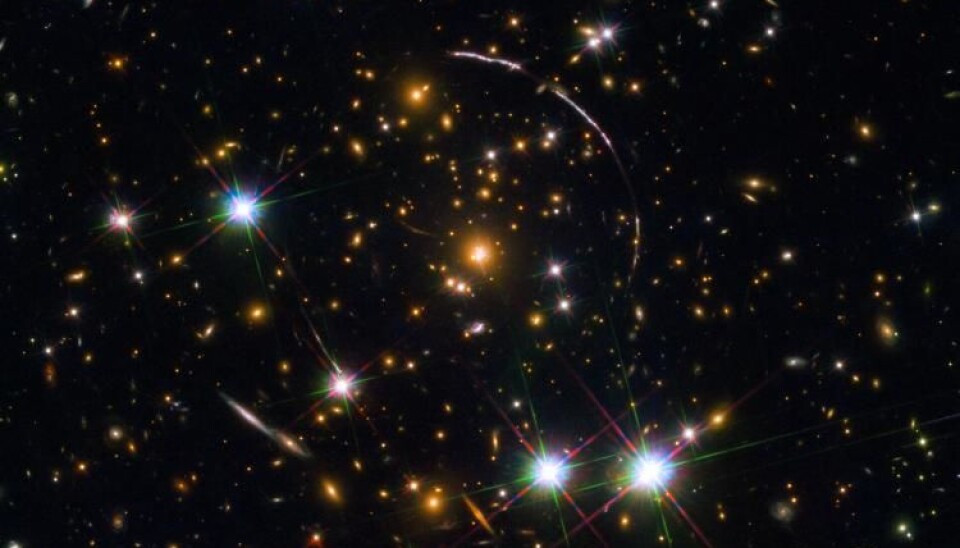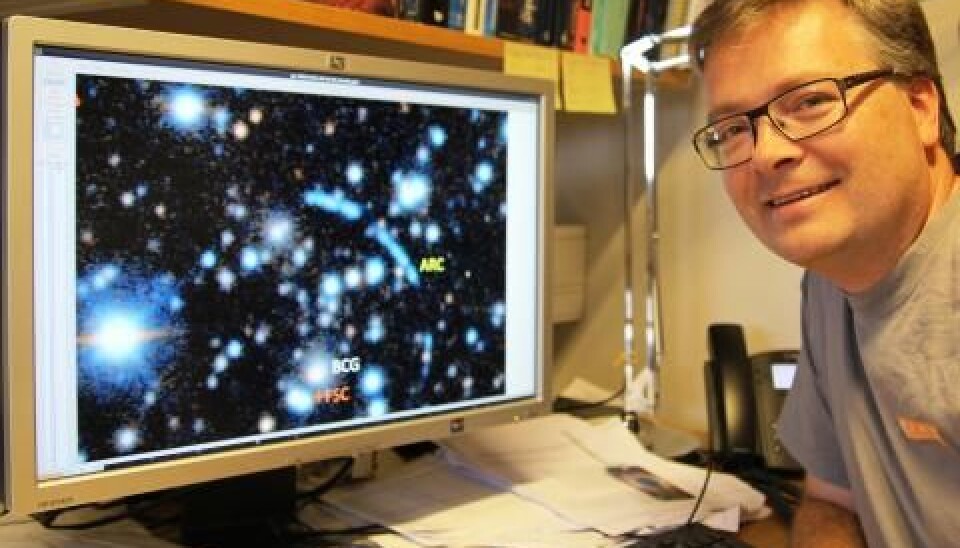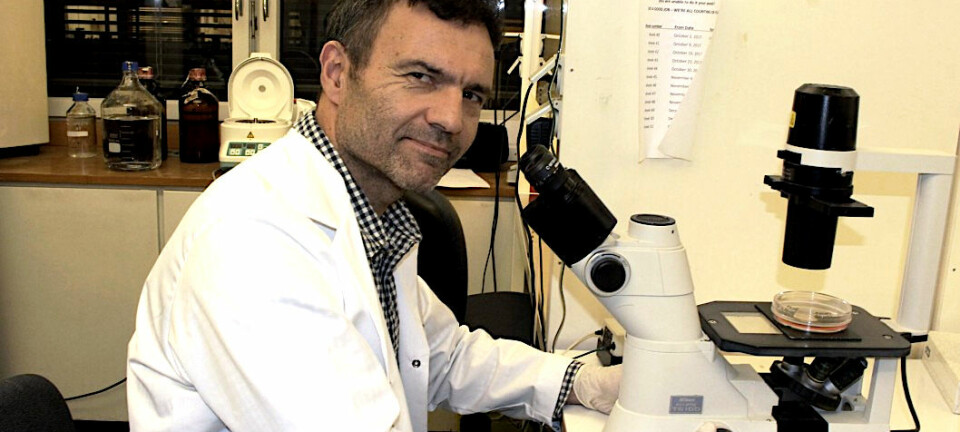This article is produced and financed by University of Oslo - read more

Astronomers observe a sunburst from the early universe – in 12 copies
With the powerful eyes of the Hubble Space Telescope, an international team of astronomers led by Håkon Dahle at UiO observed straight into the bright and hot heart of a galaxy 11 billion years old in no less than 12 multiple, gravitationally lensed images. The finding casts light onto a crucial era in our universe’s history: the epoch of reionization.
The Sunburst Arc galaxy is almost 11 billion lightyears away, however it is among the brightest lensed galaxies known. The last image obtained by the Hubble Space Telescope (HST) revealed not one, not two, but 12 multiple, gravitationally lensed images of a young, compact, extremely bright, strongly star-forming region in the heart of the galaxy. The finding is published in the prestigious journal Science on November 8th.
"From the time we discovered this galaxy a few years ago, we knew that it was a very special object", says Håkon Dahle, senior researcher in the Cosmology and Extragalactic Astronomy group at the Institute ofTheoretical Astrophysics (ITA), University of Oslo.
The Sunburst Arc galaxy shines bright with light dominated by young stars and is also highly magnified by the gravitational lensing effect, making it the brightest (in terms of its visual and ultraviolet (UV) light) galaxy that astronomers observe at such large distances from us.
A sunburst in the Universe’s history
The light we measure has spent 11 billion years to reach us, so when we study this galaxy we are looking 11 billion years back into the history of the Universe.
"We have now discovered that this galaxy is also among the few dozen galaxies where we can actually measure the type of energetic ionizing UV radiation that was produced by stars in the first galaxies during the epoch of reionization, ending the so-called "dark ages" of the Universe", says Dahle excited.
When the Universe was less than a billion years old, vast amounts of ionizing radiation poured out of the first infant galaxies and ionized the intergalactic gas over a few hundred million years. Scientists are still trying to figure out how so much radiation could escape through the thick gas cover typical of these nascent galaxies.
"The Sunburst arc with its thick, but perforated gas cover is not a typical galaxy in the local Universe or even when its light was emitted 11 billion years ago. But perhaps it is more typical for galaxies at yet earlier times", says Emil Rivera-Thorsen, former postdoc in the Extragalactic Astronomy group at ITA and lead author on the Science paper.
"If systems like the Sunburst galaxy were more common at very early times, this could possibly help balance the ledger", he adds.

A new window to the first stars
For almost all galaxies, this ionizing radiation is unobservable, being blocked either by neutral hydrogen gas inside the galaxy itself, in intergalactic space along the line of sight to the galaxy or inside our own galaxy.
"The gas-deprived channel to the central regions of the galaxy also offers a unique window to study the ionizing properties of its stars, something which cannot be done in local galaxies, not even inside the Milky Way", says Rivera-Thorsen.
Like the first galaxies, our own Galaxy contains neutral hydrogen which blocks ionizing light. The only way to observe it directly is by observing galaxies that are so far away that cosmic expansion stretches the light to longer wavelengths that are not absorbed by the Milky Way's gas. But such distant galaxies are generally far too faint to be observed in detail.
"The Sunburst Arc is sufficiently far away for its ionizing photons to reach us, and the gravitational lensing effect magnifies it enough to offer a data quality usually only available from the local universe", confirms Rivera-Thorsen.
A cosmic magnifying glass
Finding such a galaxy is rare, but the researchers' luck did not end there. The light of the Sunburst galaxy, which has travelled 11 billion light years, has been bent and focused by the tremendous mass of a foreground galaxy cluster acting as a natural lens, magnifying it a hundred times.
"Normally, such distant galaxies cover only a few pixels on our detectors and tell us very little about how the physical conditions vary with location inside the galaxy", confirms Dahle.
However, a typical galaxy or galaxy cluster acting as a strong gravitational lens usually produces from 2 to 4 observable images of the same object. Hubble’s image revealed 12 magnified images!
The magnification caused by gravitational lensing showed astronomers a zoomed-in image of the Sunburst Arc, yielding an unprecedented clear view of locations where the ionizing radiation can escape.
"This has made it possible to study the galaxy in a level of detail which is not usually possible to get for such distant objects", continues Rivera-Thorsen.
Over the past decade, the Cosmology group at ITA has been involved in the ESA Planck mission. Planck (which was launched in 2009 and continued operation until 2013) measured both the cosmic microwave background radiation, emitted when hydrogen in the universe became neutral 380,000 years after the Big Bang, and signals imprinted on this radiation by objects that formed much later. As a result of a larger European effort, the Sunburst arc was serendipitously detected for the first time by Dahle and his team.
"Neither the galaxy cluster which acts as the gravitational lens nor the Sunburst Arc itself were known before this", says Dahle.

In this way astronomers could find about six hundred previously unknown galaxy clusters, but these new Planck detections needed to be checked using optical telescopes on the ground to confirm that they were indeed real galaxy clusters.
In the spotlight of the experts
Following the discovery, the European team reached out to collaborators in the United States, which made spectroscopic observations of the Sunburst Arc using the MagE spectrograph on the 6.5-m Magellan telescope in Chile. The data revealed immediately a tell-tale sign of ionizing radiation escaping through a narrow channel in an otherwise opaque medium.
"A feature which had been theoretically predicted, but never previously observed", says Dahle.
Comparing this to sunlight shining through a break in clouds, and adding that this arc is very bright compared to other arcs, like the sun is very bright compared to other stars in our sky, the team had the inspiration to name it the Sunburst Arc.
"But we still needed data to confirm that the Sunburst Arc was "leaking" ionizing radiation as predicted, and for that we needed the Hubble Space Telescope".
Based on the theoretical modelling and analysis of the observed spectra, Dahle and his team finally submitted the HST observing proposal. The discovery at ITA which led to the Science paper was funded by the space science programme of the Research Council of Norway though the project "Long ago and far away: Viewing galaxy formation and evolution through the best cosmic magnifying glasses", for which Dahle is the project leader.
Pointing Hubble to the brightest stars
Dahle and his international collaborators will continue studying the galaxy in even more detail with the Hubble Space Telescope.
"We are particularly looking forward to obtain ultraviolet spectra in a range of wavelengths that includes the ionizing UV radiation emitted by so-called O-stars, which are the hottest (surface temperature above 30,000 Kelvin), most massive (more than 8 times the mass of the Sun) and short-lived (life spans of 1/1000 times that of the Sun) stars".
Radiation from such stars in our own galaxy power the emission of nebulae such as the Orion nebula. Yet, it is an astonishing fact that astronomers have never obtained a single good ultraviolet spectrum in the ionizing wavelength region for an O-star, the main reason being that the radiation is blocked by neutral hydrogen somewhere along the line of sight.
"The Sunburst Arc presents an unprecedented opportunity to actually measure this radiation with the Hubble Space Telescope", adds an enthusiastic Dahle.
Among other things, this will unveil how much massive binary stars (which have a different ionizing spectrum than single stars) contributed to the reionization of the Universe.
The scientific article:
Gravitational lensing reveals ionizing ultraviolet photons escaping from a distant galaxy


































